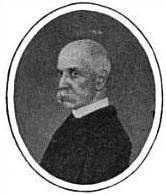Allegiance United States Name Francis Ramsay Years of service 1850–1897 | Rank Rear Admiral | |
 | ||
Born April 5, 1835Washington, D.C. ( 1835-04-05 ) Commands held USS ChoctawUSS UnadillaUSS GuerriereUSS OssipeeUSS LancasterUSS BostonUSS TrentonBureau of Navigation Died July 19, 1914, Washington, D.C., United States Education United States Naval Academy | ||
Admiral Francis Munroe Ramsay (5 April 1835 – 19 July 1914) was an officer in the United States Navy who distinguished himself in the American Civil War, and who later served as Chief of the Navy's Bureau of Navigation.
Contents

Early life and career
Born in the District of Columbia, Ramsay was appointed midshipman on 5 October 1850. After training in Preble and in St. Lawrence, he graduated from the U.S. Naval Academy in 1856. He subsequently served in Falmouth with the Brazil Squadron; in Merrimack with the Pacific Squadron; on ordnance duty at the Washington Navy Yard; and in Saratoga on the Africa Station.
Civil War service
On 23 March 1863, he assumed command of Choctaw, for duty in the Mississippi Squadron. In that gunboat, he participated in Yazoo River operations during April and May. Then on 7 June, he supported a Union garrison at Milliken's Bend, Louisiana in holding off some 4,000 Confederate troops. Moving on to Vicksburg, he commanded a battery of heavy guns mounted on scows in exposed positions before the city, 19 June–4 July. After the capture of the river stronghold, he was given command of the 3d Division, Mississippi Squadron.
During February and March 1864, he led expeditions up the Black and Ouachita Rivers and from mid-March to early May participated in Rear Admiral David Dixon Porter's expedition up the Red River. On 28 September, he was transferred to the North Atlantic Blockading Squadron in command of Unadilla.
He participated in the amphibious assaults on Fort Fisher 24 December 1864 and on 13 January 1865, and in subsequent attacks against Fort Anderson and other forts along the Cape Fear River. In April, he assisted in removing torpedoes (mines) from the James River and was present at the capture of Richmond.
Post-Civil War service
After the Civil War, Ramsay served in many and varied positions afloat; as Fleet Captain, South Atlantic Squadron and as commanding officer of Guerriere, Ossipee, Lancaster, Boston, and Trenton. Ashore, he served at the Naval Academy, at Newport, in London as naval attaché, and at Boston and New York as commandant of the Navy Yards. In 1889 he became Chief of the Bureau of Navigation and remained in that post until his retirement 5 April 1897.
He was promoted to rear admiral on 5 April 1894, and died in Washington, D.C. 19 July 1914.
Legacy
In 1918, the destroyer Ramsay (DD-124) was named in his honor.
